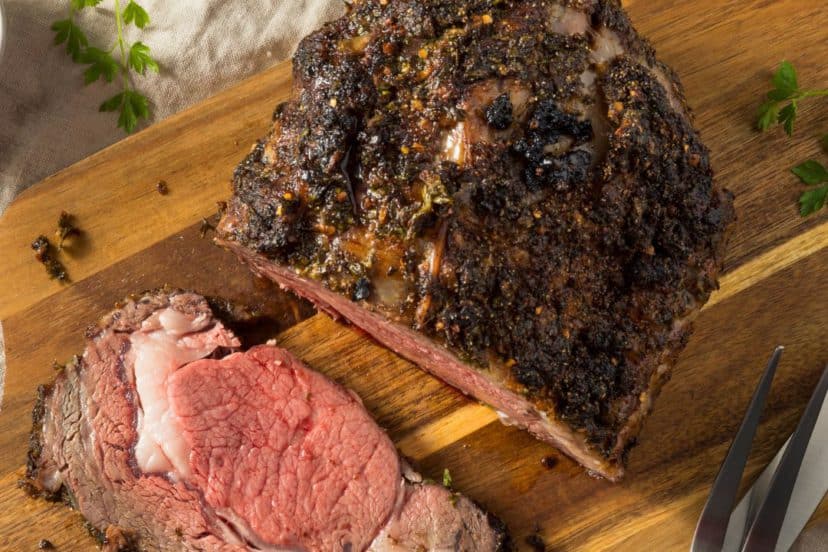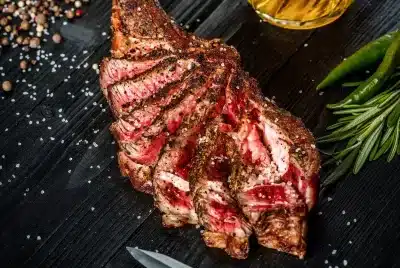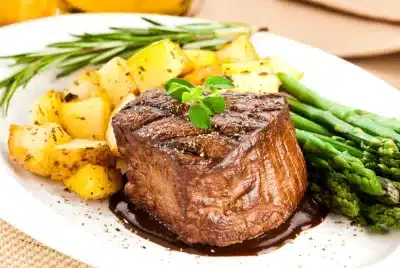Prime Rib: A Beginners Guide
Hey there, fellow outdoor cooking enthusiasts! If you’re a fan of mouthwatering, succulent meat, then you’ve come to the right place. Today, I’m here to share my secrets on how to cook the best prime rib. With its tender texture and rich flavor, it is a culinary masterpiece that can elevate any special occasion or Sunday family dinner. So, let’s dive into the world of prime rib and discover the tips and tricks to achieve perfection!
Table of Contents
- 1 What is Prime Rib?
- 2 Selecting the Perfect Prime Rib
- 3 Preparing the Prime Rib
- 4 Seasoning and Flavoring For the Best Prime Rib
- 5 Cooking Methods of Prime Rib
- 6 Resting and Carving Prime Rib
- 7 Serving Prime Rib Suggestions
- 8 Tips and Tricks for Perfect Prime Rib
- 9 Frequently Asked Questions (FAQs)
- 10 Conclusion
What is Prime Rib?
Before we get into the nitty-gritty of cooking techniques, let’s quickly understand what it is. It is, also known as a standing rib roast, is a premium cut of beef taken from the primal rib section of the cow. It’s renowned for its marbling, tenderness, and intense beefy flavor. Typically, it is bone-in, which adds extra juiciness and flavor during the cooking process.
Selecting the Perfect Prime Rib
To start your journey towards cooking this beautiful cut, it’s crucial to select the right cut of meat. Here are a few tips to help you choose the perfect one:
1. Quality Matters
Look for prime-grade or choice-grade beef for the best results. These grades ensure well-marbled meat that will melt in your mouth.
2. Consider Bone-In or Boneless
Both bone-in and boneless prime rib have their merits. Bone-in adds extra flavor and juiciness, while boneless offers easier carving.
3. Size Does Matter
When planning for the number of guests, consider approximately one pound of meat per person. It’s always better to have some leftovers than to run out.
4. Consult Your Butcher
Don’t hesitate to consult your local butcher for advice on selecting the right size and grade of beef. They can guide you and help you find the perfect cut for your needs.
Preparing the Prime Rib
Now that you have your beef in hand, it’s time to prepare it for the cooking process. Follow these steps to ensure your cut of beef is ready to be transformed into a delectable masterpiece:
1. Bring it to Room Temperature
Allow your it to sit at room temperature for about one to two hours before cooking. This step ensures even cooking and prevents the meat from drying out.
2. Pat it Dry
Before seasoning, pat it dry with paper towels. Removing excess moisture will help the seasonings adhere better and promote a beautiful crust.
3. Trim the Fat
Consider trimming excessive fat from the surface of the loin. Leave a thin layer to enhance flavor and moisture but remove any thick, undesirable sections.
4. Score the Fat Cap
To enhance the flavor and facilitate seasoning penetration, make shallow cuts in a crisscross pattern on the fat cap. Be careful not to cut into the meat itself.
Seasoning and Flavoring For the Best Prime Rib
Now that its is prepped, it’s time to impart it with irresistible flavors. Here are some seasoning and flavoring suggestions to elevate your prime rib:
1. Classic Salt and Pepper
Sometimes simplicity is the key. A generous sprinkle of kosher salt and freshly ground black pepper is enough to let the natural flavors of the beef shine through.
2. Herb Infusion
Create a herb-infused crust by combining minced garlic, fresh rosemary, thyme, and olive oil. Rub this mixture all over it, ensuring the flavors seep into every crevice.
3. Garlic and Herb Butter
For an extra burst of flavor and moisture, consider slathering the rib roast with a garlic and herb butter. Mix softened butter with minced garlic, chopped herbs, and a pinch of salt.
4. Bold Marinades
If you’re feeling adventurous, marinating can add exciting flavors. Experiment with combinations like red wine, soy sauce, Worcestershire sauce, garlic, and herbs.
Remember, the choice of seasoning and flavoring is subjective, so feel free to tailor it to your taste preferences. The key is to enhance the natural qualities of the beef while adding a delightful twist.
Cooking Methods of Prime Rib
Now comes the exciting part—cooking the meat to perfection. There are various methods to choose from, each offering a unique texture and flavor profile. Let’s explore the three most popular cooking methods:
1. Slow Roasting
Slow roasting is a classic method that yields tender, evenly cooked prime rib with a gorgeous crust. Here’s how to do it:
1. Preheat your oven to a low temperature, around 250°F (120°C).
2. Place the prime rib on a rack in a roasting pan, with the fat side up.
3. Insert a meat thermometer into the thickest part of the roast, making sure it doesn’t touch the bone.
4. Slowly roast the prime rib until it reaches your desired doneness. For medium-rare, aim for an internal temperature of 130°F (54°C).
5. Remember to factor in resting time before carving.
2. Reverse Searing
Reverse searing involves a two-step process that results in a beautifully cooked rib raost with a seared crust. Here’s how to execute it:
1. Preheat your oven to a low temperature, around 200°F (95°C).
2. Place the prime rib on a rack in a roasting pan, and insert a meat thermometer.
3. Slowly cook the prime rib until it reaches an internal temperature of about 10°F (5°C) below your desired doneness.
4. Remove the prime rib from the oven and let it rest while you preheat your grill or a cast-iron skillet.
5. Sear the prime rib on high heat for a few minutes on each side to achieve a flavorful crust.
6. Allow the meat to rest before carving.
3. Grilling
Grilling adds a unique smoky flavor and imparts grill marks for an impressive presentation. Follow these steps for a grilling experience:
1. Preheat your grill to medium-high heat.
2. Sear the prime rib on all sides to lock in the juices and create a flavorful crust.
3. Move the prime rib to indirect heat and continue grilling until it reaches your desired internal temperature.
4. Use a meat thermometer to ensure accurate cooking.
5. Rest the meat before carving.
Each cooking method has its advantages, so choose the one that aligns with your preferences and equipment. Regardless of the method, remember to let the prime rib rest before carving to allow the juices to redistribute and ensure maximum tenderness.
Resting and Carving Prime Rib
After investing time and effort into cooking, it’s crucial to give it the proper resting time and carve it with precision. Here’s what you need to know:
1. Resting the Prime Rib
Once it is cooked to perfection, resist the temptation to dig in immediately. Resting the meat allows the juices to redistribute, resulting in a juicier and more flavorful final product. Follow these steps for optimal results:
1. Transfer the cooked roast to a cutting board or a warm serving platter.
2. Tent the meat loosely with aluminum foil to retain heat.
3. Let the it rest for about 15 to 20 minutes, allowing the internal temperature to stabilize and the juices to settle.
Remember, the resting time is as important as the cooking time. So, exercise patience and resist the urge to rush the process.
2. Carving the Prime Rib
Proper carving ensures that each slice is tender, juicy, and visually appealing. Follow these steps to achieve picture-perfect slices:
1. Identify the bone side of the roast. This will serve as your starting point.
2. Using a sharp carving knife, make a gentle cut along the bone to separate it from the meat.
3. Once the bone is detached, slice the prime rib against the grain into desired thickness.
4. Aim for uniform slices, maintaining the beautiful pink center and caramelized crust in each piece.
5. Arrange the slices on a serving platter, and get ready to impress your guests.
Remember, carving technique plays a crucial role in the overall dining experience, so take your time and enjoy the process.
Serving Prime Rib Suggestions
Now that you have it cooked, rested, and perfectly carved, it’s time to present it in all its glory. Consider these serving suggestions to complement the star of the show:
1. Horseradish Cream: Offer a side of horseradish cream for a zesty kick that pairs exceptionally well with this dish.
2. Au Jus: Serve it with a rich, flavorful au jus made from the pan drippings, adding an extra layer of juiciness.
3. Yorkshire Puddings: Yorkshire puddings are classic accompaniments that add a delightful texture and absorb the savory juices.
4. Roasted Vegetables: Roast a medley of seasonal vegetables such as carrots, potatoes, and Brussels sprouts to create a vibrant and flavorful side dish.
5. Red Wine Pairing: Pair the prime rib with a robust red wine like Cabernet Sauvignon or Malbec to enhance the overall dining experience.
Feel free to personalize your serving suggestions based on your preferences and the occasion. The goal is to create a memorable meal that leaves everyone satisfied.
Tips and Tricks for Perfect Prime Rib
To take your cooking skills to the next level, here are some additional tips and tricks:
1. Use a Meat Thermometer
Invest in a reliable meat thermometer to ensure accurate and consistent cooking. This will help you achieve your desired level of doneness every time. Click here to see our favorite leave in thermometer, it’s a game changer.
2. Experiment with Rubs and Marinades
Don’t be afraid to experiment with different rubs, marinades, and seasonings to discover your favorite flavor combinations. The journey to the best prime rib is all about exploration.
3. Control the Oven Temperature
Maintaining a steady oven temperature throughout the cooking process is crucial. Use an oven thermometer to verify accuracy and make adjustments as needed.
4. Keep an Eye on the Internal Temperature
To achieve your desired level of doneness, monitor the internal temperature of the prime rib closely. Remember that it will continue to rise a few degrees during resting.
5. Let Leftovers Shine
If you have any leftovers, don’t worry!
Leftovers can be just as delightful as the initial serving. Here are a few ways to make the most of your leftovers:
1. Prime Rib Sandwich: Thinly slice the leftover prime rib and layer it on a crusty baguette or bread of your choice. Add some horseradish sauce, caramelized onions, and greens for a delicious sandwich.
2. Prime Rib Hash: Chop the leftover prime rib into small pieces and sauté it with diced potatoes, onions, and bell peppers. Season with your favorite herbs and spices for a flavorful hash.
3. Prime Rib Tacos: Shred the leftover prime rib and use it as a filling for soft tortillas. Top with fresh salsa, guacamole, and a squeeze of lime for mouthwatering prime rib tacos.
4. Prime Rib Salad: Slice the leftover prime rib and serve it over a bed of mixed greens. Add cherry tomatoes, cucumbers, crumbled blue cheese, and a tangy vinaigrette for a hearty and refreshing salad.
Remember, the possibilities are endless when it comes to repurposing leftover prime rib. Get creative and enjoy the flavors in new and exciting ways.
Frequently Asked Questions (FAQs)
1. Can I use different cuts of beef for prime rib?
Its is specifically to the rib roast cut. While you can use other cuts, the unique marbling and tenderness of this cut make it the preferred choice.
2. How do I achieve a perfect crust on my prime rib?
To achieve a flavorful crust, ensure that the its surface is dry before applying seasonings. High heat searing or using a broiler can also help create a beautiful crust.
3. What is the ideal internal temperature for a medium-rare prime rib?
For a medium-rare , aim for an internal temperature of around 130°F (54°C). However, individual preferences may vary, so adjust accordingly.
4. Can I cook prime rib on a charcoal grill?
Absolutely! Grilling it over charcoal imparts a smoky flavor and adds a unique touch to the overall taste. Follow the grilling method mentioned earlier for best results.
5. How long can I safely store leftover prime rib?
Leftovers can be refrigerated for up to 3 to 4 days. Ensure proper storage in an airtight container or wrap it tightly in foil or plastic wrap.
Conclusion
Congratulations! You’ve now unlocked the secrets to cooking the best prime rib. From selecting the perfect cut to mastering various cooking methods, seasoning to resting and carving, you are well-equipped to create a masterpiece. Remember to experiment, trust your instincts, and enjoy the process. So fire up that grill or preheat your oven, and get ready to impress your family and friends with a mouthwatering prime rib feast. Happy cooking!
*We may earn a commission for the purchases made using our links. Please see our disclosure to learn more.




